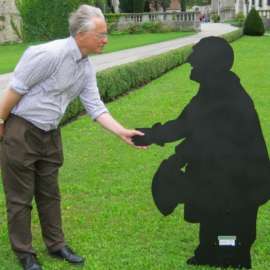After the overture, whose two movements, fast and slow, were adequately dispatched by a suitably small orchestra, the audience mistook the arrival of an orchestral horn player as that of the soloist himself, and burst into applause, which turned to laughter as the mistake became obvious. And this atmosphere of benign jollity was continued by the soloist proper, Martin Owen, who gave us a comic cadenza in which short blirrups were followed by a stunned stare at the audience as if he himself was surprised at what he’d just played. More convoluted virtuosic manoeuvres were accompanied by bending the knees and wiggling the hips. His playing in the first movement had been of very seductive beauty, a quality amplified in the serene Romanza, beautifully phrased, and then the famous Rondo finale was accomplished with suitable wit and aplomb, the final appearance of the theme played quietly, Owen crouching low, and then up again to take us to the movement’s wild and joyful end.
Rather as the reputation of the No. 8 London bus that it was for some years my privilege to drive, the No. 8 Bruckner symphony seems hard to come by - and then suddenly two come along together. The previous evening there had been a fine performance by the Fulham Symphony Orchestra, and this following afternoon the work was presented again in Brighton. It would be wrong to say it sounded like two different symphonies, but they were very different performances indeed. The Brighton Philharmonic draws many of its players from the major London orchestras, and the quality of the orchestral playing in the Bruckner was excellent throughout. Perhaps the first trumpet, John Ellwood, had at times received too much encouragement from the conductor, though one would forgive him anything for his spine-tingling final fanfare in the midst of the symphony’s closing apotheosis. It was a great moment.
There were many great moments in this performance, and this was both its strength and, I felt, its limitation. Maestro Stephen Bell would have them play every section for all that it was worth, and this certainly made for a tremendous and shattering first movement. The extraordinary climax in which trumpets alone blare out the bare rhythm of the main theme, Bruckner’s ‘Annunciation of Death’, gave the movement its high point and its destination, and the relative terseness of Bruckner’s writing in this movement meant that it all held together wonderfully. But the Adagio, and especially the Finale, though full of wonderful, wonderful things, didn’t quite add up to the sum of their parts. It was a performance which you had to enjoy for its immediate dramatic glories, not so much for its cumulative power.
Amongst those glories were some beautiful clarinet and oboe playing in the opening of the development in the first movement, the dialogue between solo horn and oboe that followed, wonderful blazing tuttis throughout the outer movements, and noble chorale-like statements from the horns and Wagner tubas in the Adagio and Finale. For all my reservations about the overall grasp of form, the Adagio was nevertheless extremely beautifully played by the strings, very moving; the overwhelming climax with its closing exposed harp arpeggio was perfectly managed, the wind-down to the heart-rending melancholy dialogue between horns and violins was spellbinding.
The Finale is never easy to hold together and keep its sense of direction. Everything here was well played, but tension eased off a bit in a way that it need not necessarily do. It was best just to sit back and revel in the glorious sound of it all, and wait patiently for that mighty coda, resplendent, joyful, victorious over the dark and deathly forces with which the symphony began.


